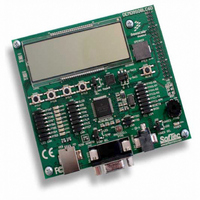DEMO9S08LC60 Freescale Semiconductor, DEMO9S08LC60 Datasheet - Page 29

DEMO9S08LC60
Manufacturer Part Number
DEMO9S08LC60
Description
BOARD DEMO FOR 9S08LC60
Manufacturer
Freescale Semiconductor
Type
MCUr
Datasheets
1.DEMO9S08LC60.pdf
(360 pages)
2.DEMO9S08LC60.pdf
(32 pages)
3.DEMO9S08LC60.pdf
(2 pages)
Specifications of DEMO9S08LC60
Contents
Evaluation Board
Processor To Be Evaluated
MC9S08LC60
Interface Type
RS-232, USB
Silicon Manufacturer
Freescale
Core Architecture
HCS08
Core Sub-architecture
HCS08
Silicon Core Number
MC9S08
Silicon Family Name
S08LC
Rohs Compliant
Yes
For Use With/related Products
MC9S08LC60
Lead Free Status / RoHS Status
Lead free / RoHS Compliant
- Current page: 29 of 360
- Download datasheet (4Mb)
2.3.1
V
I/O buffer circuitry and to an internal voltage regulator. The internal voltage regulator provides regulated
lower-voltage source to the CPU and other internal circuitry of the MCU.
Typically, application systems have two separate capacitors across the power pins. In this case, there
should be a bulk electrolytic capacitor, such as a 10-μF tantalum capacitor, to provide bulk charge storage
for the overall system and a 0.1-μF ceramic bypass capacitor located as close to the MCU power pins as
practical to suppress high-frequency noise.
V
the ADC. A 0.1-μF ceramic bypass capacitor should be located as close to the MCU power pins as
practical to suppress high-frequency noise.
2.3.2
V
module. In the 64-pin package, V
2.3.3
Out of reset, the MCU uses an internally generated clock (self-clocked mode — f
approximately equivalent to an 8-MHz crystal rate. This frequency source is used during reset startup and
can be enabled as the clock source for stop recovery to avoid the need for a long crystal startup delay. This
MCU also contains a trimmable internal clock generator (ICG) module that can be used to run the MCU.
For more information on the ICG, see
The oscillator in this MCU is a Pierce oscillator that can accommodate a crystal or ceramic resonator in
either of two frequency ranges selected by the RANGE bit in the ICGC1 register. Rather than a crystal or
ceramic resonator, an external oscillator can be connected to the EXTAL input pin, and the XTAL output
pin can be used as general I/O.
Refer to
resistors such as carbon composition resistors. Wire-wound resistors, and some metal film resistors, have
too much inductance. C1 and C2 normally should be high-quality ceramic capacitors that are specifically
designed for high-frequency applications.
R
value is not generally critical. Typical systems use 1 MΩ to 10 MΩ. Higher values are sensitive to humidity
and lower values reduce gain and (in extreme cases) could prevent startup.
C1 and C2 are typically in the 5-pF to 25-pF range and are chosen to match the requirements of a specific
crystal or resonator. Be sure to take into account printed circuit board (PCB) capacitance and MCU pin
capacitance when sizing C1 and C2. The crystal manufacturer typically specifies a load capacitance which
is the series combination of C1 and C2 which are usually the same size. As a first-order approximation,
use 10 pF as an estimate of combined pin and PCB capacitance for each oscillator pin (EXTAL and
XTAL).
Freescale Semiconductor
F
DD
DDAD
REFH and
is used to provide a bias path to keep the EXTAL input in its linear range during crystal startup and its
and V
and V
Figure 2-3
V
Power (V
ADC Reference Pins (V
Oscillator (XTAL, EXTAL)
SS
REFL
SSAD
are the primary power supply pins for the MCU. This voltage source supplies power to all
are the voltage reference high and voltage reference low pins, respectively, for the ADC
are the analog power supply pins for the MCU. This voltage source supplies power to
for the following discussion. R
DD
, V
MC9S08LC60 Series Data Sheet: Technical Data, Rev. 4
SS
, V
REFH and
DDAD
Chapter 10, “Internal Clock Generator
V
REFH
, V
REFL
SSAD
, V
are shared with V
S
(when used) and R
REFL
)
)
DDAD
F
should be low-inductance
and V
(S08ICGV4).”
Chapter 2 Pins and Connections
SSAD
Self_reset
, respectively.
), that is
29
Related parts for DEMO9S08LC60
Image
Part Number
Description
Manufacturer
Datasheet
Request
R
Part Number:
Description:
Manufacturer:
Freescale Semiconductor, Inc
Datasheet:
Part Number:
Description:
Manufacturer:
Freescale Semiconductor, Inc
Datasheet:
Part Number:
Description:
Manufacturer:
Freescale Semiconductor, Inc
Datasheet:
Part Number:
Description:
Manufacturer:
Freescale Semiconductor, Inc
Datasheet:
Part Number:
Description:
Manufacturer:
Freescale Semiconductor, Inc
Datasheet:
Part Number:
Description:
Manufacturer:
Freescale Semiconductor, Inc
Datasheet:
Part Number:
Description:
Manufacturer:
Freescale Semiconductor, Inc
Datasheet:
Part Number:
Description:
Manufacturer:
Freescale Semiconductor, Inc
Datasheet:
Part Number:
Description:
Manufacturer:
Freescale Semiconductor, Inc
Datasheet:
Part Number:
Description:
Manufacturer:
Freescale Semiconductor, Inc
Datasheet:
Part Number:
Description:
Manufacturer:
Freescale Semiconductor, Inc
Datasheet:
Part Number:
Description:
Manufacturer:
Freescale Semiconductor, Inc
Datasheet:
Part Number:
Description:
Manufacturer:
Freescale Semiconductor, Inc
Datasheet:
Part Number:
Description:
Manufacturer:
Freescale Semiconductor, Inc
Datasheet:
Part Number:
Description:
Manufacturer:
Freescale Semiconductor, Inc
Datasheet:










